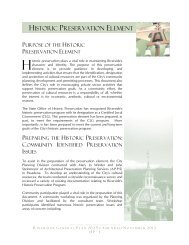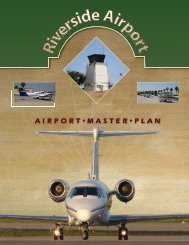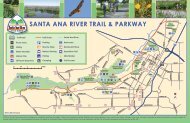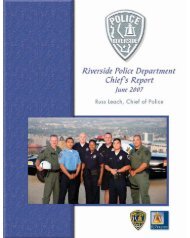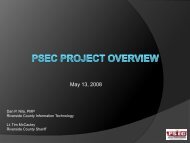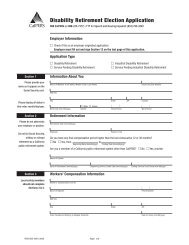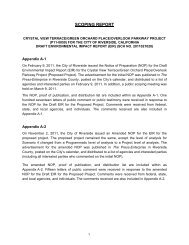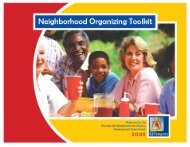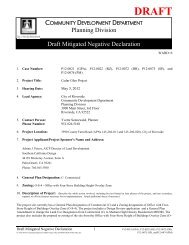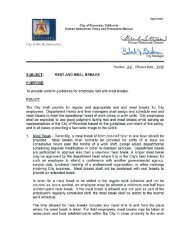Northside - City of Riverside
Northside - City of Riverside
Northside - City of Riverside
You also want an ePaper? Increase the reach of your titles
YUMPU automatically turns print PDFs into web optimized ePapers that Google loves.
V. METHODOLOGY<br />
Methodology for planning and conducting the Reconnaissance Survey and Context<br />
Statement for a Portion <strong>of</strong> the <strong>Northside</strong> project, which included an oral history<br />
component, was guided by National Register Bulletin 24: Guidelines for Local Surveys:<br />
A Basis for Preservation Planning and Instructions for Recording Historical Resources<br />
(March 1995), and project deliverables were prepared in accordance with the<br />
Secretary <strong>of</strong> the Interior’s Standards for Preservation Planning, Identification, Evaluation,<br />
and Registration, as applicable.<br />
As the survey results and the identification <strong>of</strong> potentially significant individual and<br />
district resources were primarily for use in local preservation and planning, JRMC<br />
balanced historic preservation tenets with the purposes expressed in the <strong>City</strong> <strong>of</strong><br />
<strong>Riverside</strong>’s Cultural Resources Ordinance (Title 20, Ord. 6263 (1996), as amended).<br />
This merge <strong>of</strong> historic preservation with community development planning<br />
provides the basis for the protection <strong>of</strong> the <strong>City</strong>’s historic resources, while facilitating<br />
the effective use <strong>of</strong> resources that are determined not significant under federal, state,<br />
and local preservation law.<br />
In May 2005, a comprehensive revision to Title 20 was initiated by the <strong>Riverside</strong> <strong>City</strong><br />
Council, and a committee was formed to evaluate the current ordinance and<br />
recommend improvements. Because changes to the cultural resources ordinance<br />
were not finalized prior to the completion <strong>of</strong> this survey, JMRC used the adopted<br />
ordinance (Ord. 6263 (1996), as amended) for guidance in determining local<br />
preservation goals and objectives and for evaluating extant resources within the<br />
survey area (Appendix I).<br />
VI.<br />
RESEARCH DESIGN<br />
Specific techniques outlined in National Register Bulletin 24: Guidelines for Local<br />
Surveys: A Basis for Preservation Planning and Instructions for Recording Historical<br />
Resources (March 1995) helped guide the practical conduction <strong>of</strong> fieldwork, the<br />
organization <strong>of</strong> archival research, the completion <strong>of</strong> oral history sessions, the<br />
development <strong>of</strong> the historic context statement, the incorporation <strong>of</strong> existing data, the<br />
recordation <strong>of</strong> survey data, and the evaluation <strong>of</strong> historic resources. In addition,<br />
JMRC applied techniques that have proven successful in past survey efforts to<br />
complete the reconnaissance survey <strong>of</strong> a portion <strong>of</strong> the <strong>Northside</strong>.<br />
It was anticipated prior to commencement <strong>of</strong> the survey that potentially significant<br />
individual and district resources would be evaluated at all levels - National, State,<br />
and local - using the criteria established for inclusion in the National Register <strong>of</strong><br />
6



